With e-commerce becoming more popular than ever before, thousands of e-commerce enthusiasts are probably wondering where to start their online business venture. If you’re among them, and Shopify and Amazon are at the top of your list of candidates, this article may help you in your search.
Shopify and Amazon exemplify two contrasting e-commerce models. Both platforms have certain advantages and drawbacks. In this Shopify vs. Amazon comparison, we’ll take a look at some of their features and the pros and cons of using them. So, let’s dive into it.
Table of Contents
What Is Shopify?
In short, Shopify is an e-commerce platform that integrates with a host of other apps and lets you build your own e-commerce website/store. The emphasis here is on your own.
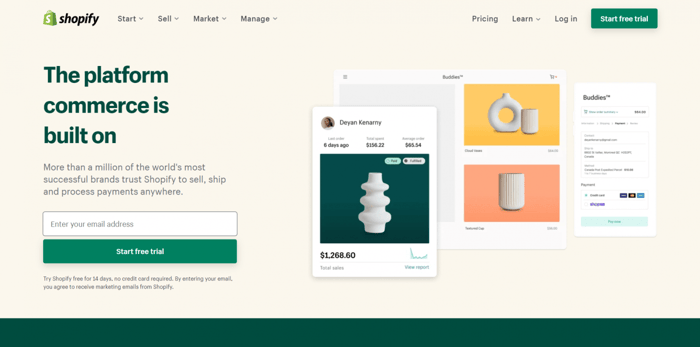
Shopify combines its natively developed software with third-party software to provide the best possible user experience. It’s known for being a smooth, almost technically flawless web platform whose objective is to enable any user out there to build and run their stand-alone e-commerce store. It’s one of the platforms that heavily contributed to the democratization of the e-commerce world, making it possible for almost any entrepreneur to build their brand, regardless of their budget and the size of their business.
Given that 4.0% of all websites on the internet are powered by Shopify, it’s one of the most widely used platforms in the world. More precisely, it comes in second place, behind WordPress. Over 4.8 million websites were built on this platform, more than 3.4 million of which are currently active. In September 2021, Shopify registered about 54 million total visits. In 2020, its annual revenue was $2.9 billion. Impressive, right?
What Is Amazon?
Amazon is an e-commerce company and one of the largest online marketplaces ever. You can sell everything you want on Amazon as long as it’s not on the list of things prohibited by its category, product, and listing restrictions.

Amazon is very different from Shopify. While Shopify represents the build-your-own-website model, Amazon exemplifies a different approach; you can’t build your own e-commerce website with a separate and recognizable custom domain name, but you can sell your goods on their site. Amazon is similar to Udemy or Etsy or, for that matter, any other ginormous marketplace. You don’t own a stand-alone e-commerce store, but you get your spot and plenty of opportunities to sell to the members of one of the largest customer communities in the world.
Speaking of which, Amazon has recently made considerable steps toward creating a possibility for its sellers to build a store. However, it still doesn’t seem to be the real deal, at least not in the sense of what most people mean when they talk about e-commerce stores. But more on that later.
When it comes to numbers, Amazon fares extremely well. With over 2.4 billion total visits in September 2021, 16.7 million websites that use Amazon as a sales channel, and $386 billion of annual revenue in 2020, it’s obvious that Amazon is one of the industry giants.
Customers
Whose Customers Are These?
Shopify
In Shopify, your customers are your customers. They buy from you, they’re familiar with your brand and e-commerce site, and they’re members of your loyal community of customers. Shopify gives you the means and tools to build your own e-commerce business, but it doesn’t claim the right to your audience and customers. This is not quite the case with Amazon.
Amazon
When you sell on Amazon, you sell to Amazon customers, both de jure and de facto. Amazon is building its customer base, and it makes sure over and over again that you understand this clearly. Suffice it to say, in its Selling Policies and Seller Code of Conduct Amazon uses the term “our customers” whenever it refers to users who buy on the platform.
Brand Awareness
Shopify
With a Shopify store as well as some selling/marketing experience under your belt, you can be well on your way to building brand awareness. Whenever users buy something in your store, they’ll know they bought it from you. When your satisfied customers spread the word, they’ll spread the word about your brand, not about some giant marketplace full of nearly anonymous sellers.
Amazon
People buy on Amazon often not even knowing exactly whose products they are purchasing. When we ask our friends where they bought that great book or raincoat or whatnot, they are likely to say “on Amazon.”
It’s so easy to disappear in the sea of millions of Amazon sellers. Offering in the same place along with gazillions of other sellers makes it difficult to create awareness about yourself as a separate seller and your brand.
However, things are starting to get much better now with the new option that allows you to build a branded store on Amazon, but let’s see if they’re quite there yet.
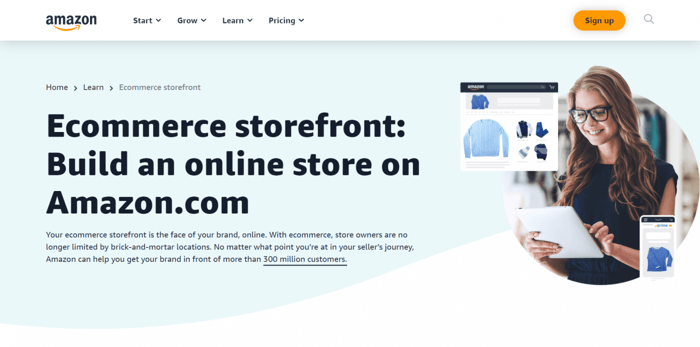
Thanks to this possibility, you can create a multi-page store for free. The only prerequisites are to sign up for the Professional selling plan and enroll in the Amazon Brand Registry. An Amazon store gives you access to a set of pre-built designs to choose from, social media share buttons, analytics, the ability to run marketing campaigns, split testing, and more. Moreover, users who visit your Amazon store won’t see any other sellers’ products or ads, which was one of the biggest pain points before.
The downside is that you’re still part of the Amazon marketplace. For starters, you can’t have a custom domain name. Instead, as Amazon puts it, you “get your own amazon.com web address.” For instance, this is an example of how an Amazon store looks (pay attention to the highlighted URL):
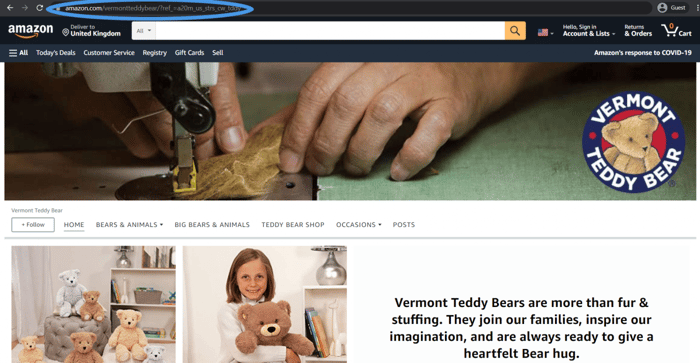
No doubt, it is different. But at the same time, it’s the same old recognizable Amazon look that we’ve grown accustomed to. This is never the case with Shopify. You can visit a ton of Shopify-built stores without even knowing that they were all built on Shopify. That’s how different they can look. Apart from the recognizable Shopify checkout, there’s no other way to tell the difference.
Another drawback is that this feature is not widely supported yet. It’s currently available only in North America, Brazil, six countries in Europe (plus the UK), two in the Middle East, and four in the Asia Pacific. For a list of the specific countries, have a look at this Amazon page.
Regardless, this new Amazon feature is still a huge improvement and presumably great news for a considerable number of Amazon sellers.
Customer Community
Shopify
On the flip side, it’s much harder to get sufficient traffic and build a customer community on Shopify, especially if you haven’t previously built a significant following on social media.
Often, with a Shopify e-commerce store, you’re building your customer base from the ground up through your sales and marketing strategies and tactics. And, as we all know, starting from scratch can be a frustrating and time-consuming experience. The more inexperienced you are, the harder it can be.
Amazon
Amazon, on the other hand, gets millions of visitors every day. This, along with the sheer number of loyal Amazon customers, increases your chances of someone seeing the goods you offer and making a purchase. You don’t need to lift a finger – you get access to this traffic and community from the get-go. However, it doesn’t mean that success on Amazon comes overnight without any effort on your side.
Amazon is a massive marketplace. Similar to how a search engine works, not everyone gets to show up on the first couple of pages in users’ searches. You need to find ways to promote what you sell and make Amazon list you higher. In simple terms, it’s not all roses when it comes to promoting and selling on Amazon either.
Costs
Pricing Plans
Shopify
Both Shopify and Amazon have fairly straightforward pricing plans, although Amazon’s plans may seem simpler than the ones Shopify offers.
These are the Shopify plans:
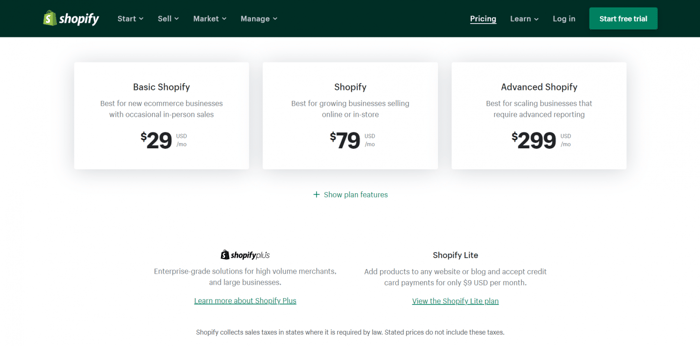
The Shopify Plus plan costs $2,000/month, but since it’s a custom plan, the fee can be higher depending on your requirements.
Amazon
These are the Amazon selling plans:
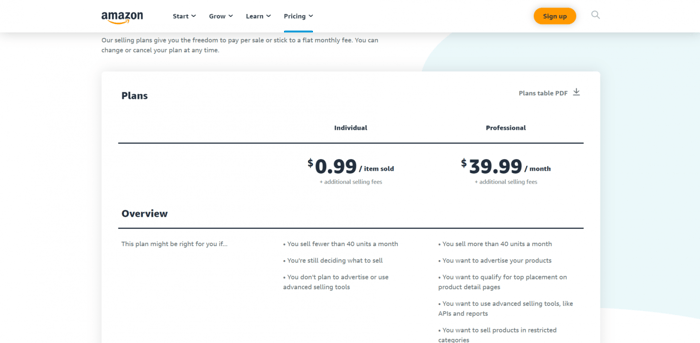
Based on the pricing plans only, Amazon is overall a much more affordable e-commerce platform. We can safely assume that the low upfront costs are one of the reasons many e-commerce enthusiasts decide to sell on Amazon.
However, the pricing plans alone are not sufficient to gain a complete picture of how much it costs to run an e-commerce business on these two platforms and how cost-effective they are. So, let’s examine the other costs and fees.
Additional Fees at Shopify
Shopify offers its own payment processor – Shopify Payments. One of the perks of using it is that it doesn’t include transaction fees. The biggest downside to it is that only e-commerce businesses in 17 countries can take advantage of it.
If you don’t use Shopify Payments, Shopify charges different transaction fees, depending on your pricing plan. These are the transaction fees together with the online and in-person credit card rates for each of the plans – Basic Shopify, Shopify, and Advanced Shopify (left to right):

In addition to this, you pay a (currency) conversion fee of 1.5% for a store registered in the U.S. and 2% for any other region in the world.
Additional Fees at Amazon
The seller plans may look simple at first glance, but tracking and calculating the total costs on Amazon is anything but. Due to the complex nature of this aspect of Amazon, we won’t get into too much detail. Instead, we’ll provide some basic information and links to where you can find an in-detail explanation of the Amazon fees.
In addition to the regular selling plan fees, Amazon charges:
- Referral fees – a cut of the total price of a sold product, where the minimum amount is usually $0.30 while the highest varies depending on the type of product.
- FBA (Fulfillment by Amazon) fees – from $2.16 to $6.08 + $0.30/lb above the first 3 lbs for apparel and from $2.16 to $138.11 + $0.79/lb above the first 90 lbs for non-apparel products.
- FBA storage fees – from $0.48 to $2.40 per cubic foot.
- Additional inventory fees, and more.
Amazon even provides you with an online tool to calculate the approximate amount of your sales margin. You can find the online calculator as well as a detailed explanation of the Amazon fees and charges here.
Credibility
Shopify
Building a relationship of trust with your clientele is one of the key factors for a successful business. With a Shopify store, it’s a bit more difficult to achieve this, but it has nothing to do with Shopify itself. It’s just a part of running a stand-alone online store. You’ve got to work continuously on making a name for yourself and delivering on what you say.
It’s hard to believe that someone will decide to buy from you by stumbling upon your e-commerce site on the internet. Without having at least some indicator of your store’s credibility – for instance, authentic positive reviews and testimonials or some other sort of verifiable information – it’s difficult to persuade users to leave their credit card information and make a purchase. You can be the most sincere entrepreneur in the world, with the best products, but it would still be difficult for users to share their private and card information with a person or entity they don’t know.
Amazon
In contrast, Amazon is already an extremely well-established brand – an e-commerce institution. People buy on this platform without any concerns about the company’s credibility. It has a strong
presence in the e-commerce market niche and it’s one of the most credible online marketplaces. Amazon has been part of our lives for long enough to become a household name.
By selling on Amazon, you inherit its credibility, but you’ve got to keep up with it and build upon it. With bad reviews, no one will even give you the benefit of the doubt, let alone buy the products you offer.
Blogging
Shopify
Blogging is a key part of today’s content marketing strategies. It can help you build a much stronger online presence, reach new users, increase traffic to your site, and improve conversion rates. When it comes to building a brand, a blog is a must.
Shopify offers multiple blogging options. For starters, it has its own blogging solution that’s included in the Shopify out-of-the-box features. It’s a simple and useful tool, but it can’t do much in terms of serious and frequent blogging. For that, you’ll be much better off if you use a specialized third-party blogging solution.
Luckily, the Shopify App Store offers tons of extensibility options – over 6,000 apps and counting – and blogging software is surely not left out of one of the largest app ecosystems in this niche.
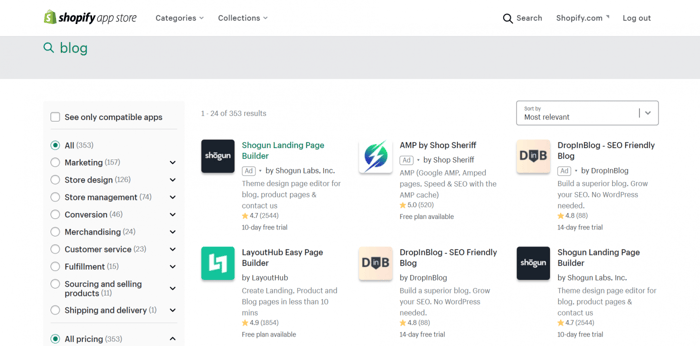
One app that sticks out and that’s dedicated exclusively to blogging is DropInBlog. It’s a full-featured blogging solution with a beautiful design, powerful tools, and a simple interface. Like any other direct integration, you can just add it to your Shopify store and start using it in no time.
Amazon
Content marketing, or more precisely blogging, is the one area where Shopify crushes Amazon. Due to its nature as a marketplace, not a full-fledged e-commerce site/store builder, Amazon lacks this feature. Of course, you can have a blog where you promote the products you sell on Amazon, but that’s not what we’re discussing here. We’re talking about an Amazon-built blog and that’s something that’s completely missing from this e-commerce platform.
Amazon Private Labels
A potentially big problem for Amazon sellers is that they have to compete not just with each other, but against Amazon products as well.
In case you’re not familiar, around 2009 Amazon started investing in the private label business and now owns hundreds of different brands that sell all types of products that you won’t find anywhere else but on Amazon.com. The tricky part is to figure out which of the brands actually belong to Amazon because this e-commerce giant doesn’t necessarily associate with them publicly.
Moreover, as it’s been reported over the last few years – in a New York Times article from 2018 as well as in the Washington Post in 2019 – Amazon isn’t necessarily playing fair.
One of the tactics Amazon applies is it usually offers its products for considerably lower prices than its competition. Another is when you consider buying a certain product, it suggests for you a similar product of its own (for a lower price). In short, it favors its own products and private label brands, which has brought Amazon significant profits in the past, as the New York Times article explains, and presumably brings even more in the present.
So, it looks like regular Amazon sellers have a fierce competitor on their hands.
Point of Sale
Shopify
One of the biggest assets of Shopify is its POS (Point of Sale) system. It’s the tool that allows Shopify to work for in-store (in-person) payments in addition to online payments. In other words, regardless of whether you own an online store or a brick-and-mortar store, Shopify works for both.
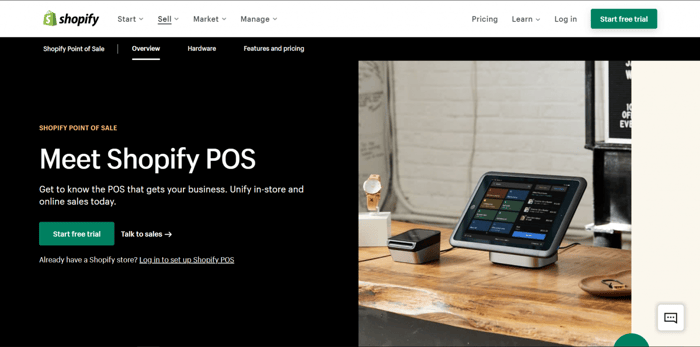
Having these options for some time now has been music to the ears of Shopify customers and e-commerce enthusiasts. This is, undoubtedly, one of the features that makes Shopify stand out from its competition and appeal to so many merchants. The best thing is that you get access to the Shopify POS by signing up for any of the pricing plans.
Amazon
Thanks to its POS system, Shopify operates in two areas: online sales and offline sales. Unfortunately for Amazon and its sellers, this company doesn’t cover the second area. That is, not yet. There have been rumors for some time that Amazon is working on its own POS system and many articles published recently confirm this.
We’ll have to wait and see what happens, but it won’t come as a surprise if Amazon announces this new addition to its assortment of tools very soon, which can be great news for Amazon sellers.
Final Thoughts
What can we conclude based on our research and this Shopify vs. Amazon comparison?
Amazon is one of the best places to start selling. It’s simple, has low upfront costs, and is easy to use. However, it’s not necessarily the best option when your business takes off. It offers limited options for growing businesses and, at some point, due to the many fees, it starts looking like it’s eating up your profit.
On the contrary, Shopify can be overwhelming at the beginning. It’s not that cheap and it requires a sort of DIY approach (you do everything yourself: boosting traffic, building a brand, marketing to customers, etc.). However, when your e-commerce venture starts to look like it’ll have a bright future, Shopify is the platform to go for. It’s great for long-term projects, growing businesses, and startups that are looking to work on their brand from the get-go. It provides sellers with so much right off the bat as well as in terms of extensibility and customizability.
So which one suits your business best?




